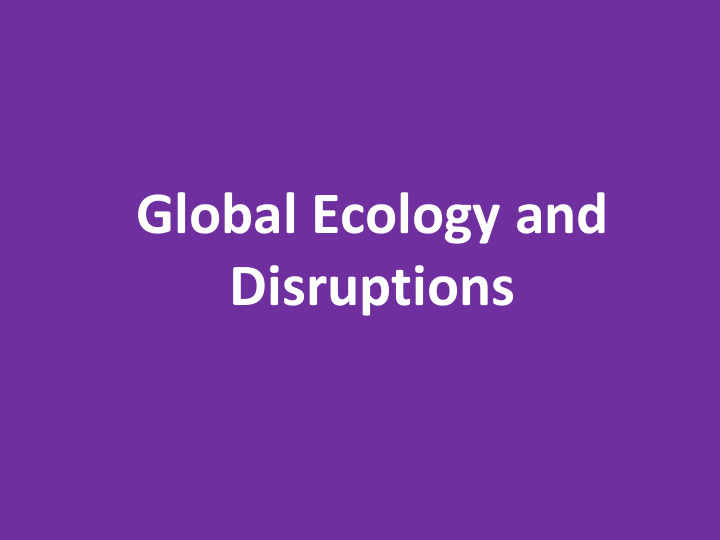



Global Ecology and Disruptions
What is biodiversity? How do we measure biodiversity?
Biodiversity • The total variety of life on Earth • 1.4 to 1.8 million named species • Estimates are between 3 and 30 million species (Why is there such a big range?)
Three Levels of Biodiversity • Genetic Diversity • Species Diversity • Ecosystem Diversity
Genetic Diversity • Comprises the individual genetic diversity within a population and the genetic variation between populations of the same species • Measure allele variation per locus • Variation between populations is often associated with adaptation to local environments
Allele Variation Per Locus
Genetic Diversity • Reduces the risk of extinction in the event of an environmental change Cheetahs Happy Face Spiders (low genetic diversity) (high genetic diversity)
Species Diversity • The variety of species in an ecosystem or throughout the biosphere • As species go extinct, species diversity decreases (local and global extinction) • Species may be classified as endangered or threatened
World Biodiversity Hotspots
Ecosystem Diversity • Variety of the biosphere’s ecosystems • Network of community interactions between populations • Local extinction of one species can negatively impact the overall species richness of the community (see bat example in textbook)
Natural and artificial ecosystems with little diversity are less resilient to changes in the environment
Why is biodiversity important?
Biodiversity Conservation • All species are interconnected – the loss of one species will affect the survival of other species
Biodiversity Conservation • Potentially provide crops, fibers, and medicines for human use (natural resource) • Ecosystems purify our air and water, detoxify and decompose waste, reduce the impact of extreme weather and flooding • Crop pollination, control pests, create and preserve soil
What are the threats to biodiversity?
Extinction • Natural phenomenon that has been occurring since life first evolved (5 mass extinctions) • Rate of extinction is causing today’s biodiversity crisis
Threats to Biodiversity • Formerly known as “HIPPO”, now we have “HIPPCO” • H – Habitat Destruction/Loss • I – Invasive Species • P – Pollution • P – Population Expansion • C – Climate Change • O – Overharvesting
H – Habitat Destruction • Slash and burn agriculture – Results in nutrient poor soil with no vegetation (why?) • Habitat fragmentation • Logging
H- Habitat Destruction • Permanent destruction of forests in order to make the land available for other uses (agriculture, urban development, mining, etc.) • Roughly 18 million acres of forest are lost per year
I - Invasive Species • A species living outside of its native geographic range, introduced through human activity • Few or no predators • Outcompete native species for resources • Reproduce quickly • Adversely affect habitats and biodiversity
Invasive Species Briefly research one of the following invasive species: • Kudzu • Nile Perch • Cane Toad • Burmese Python • Brown Tree Snake • Asian Longhorned Beetle
Introduction of New Diseases • New diseases are introduced into ecosystems by transferring species from their native areas to non-native areas (decreases biodiversity) • Examples: Dutch Elm Disease and Potato Blight • Dutch Elm Disease is a fungus, brought to the US in the 1920s from Europe • Spread by bark beetles • Destroyed millions of elm trees
P - Pollution
P – Population Expansion of Humans • As human populations have increased in numbers, our impact on habitats for other species have been magnified • Reduced the population, and in some cases, caused the extinction of other species
P – Population Expansion of Humans
C – Climate Change • Shifts the distribution of organisms based on temperature, elevation, pH • Increase in global mean temperatures, ocean temperatures, sea level rising, ocean acidification
O - Overharvesting • Harvesting a renewable resource at a rate that is unsustainable, given their natural rates of mortality and capacities for reproduction • Example: 100 million metric tons of aquatic life
What are natural threats to biodiversity?
Natural Disasters Threaten Biodiversity • Hurricanes, floods, earthquakes, volcanoes, fires, etc.
Geological and Meterological Events Impact Ecosystems • Continental Drift • Meteor Impact on Dinosaurs • El Niño
El Niño • Temporary change in the climate of the Pacific Ocean (increases a few degrees) • Huge effect on the world’s climate
El Niño • Heavy rains to Pacific Islands and west coast of South America • Drought to Australia, Indonesia, Philippines, Africa, India • Mild winters to the Northeast
Recommend
More recommend